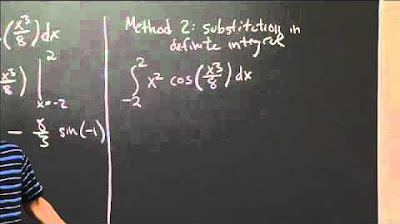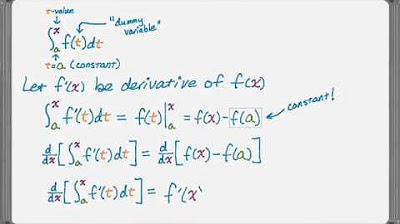Second fundamental theorem and chain rule | MIT 18.01SC Single Variable Calculus, Fall 2010
TLDRIn this recitation video, the professor guides students through the application of the fundamental theorem of calculus and the chain rule to find the derivative of a composite function involving an integral. The problem involves differentiating the integral from 0 to x squared of the cosine function, which is not directly solvable by the fundamental theorem alone due to the presence of x squared. The solution process is clearly explained, demonstrating how to handle more complex integral expressions by combining these two mathematical concepts, ultimately arriving at the answer, 2x times cosine of x squared.
Takeaways
- 📚 The problem involves finding the derivative of an integral, specifically ∫ from 0 to x squared of cosine t dt.
- 🤔 The challenge is that the integral is of a function of x (x squared), not just x, which complicates the application of the fundamental theorem of calculus.
- 🌟 The solution strategy combines the fundamental theorem of calculus with the chain rule to tackle the problem.
- 📈 Define F(x) as the integral from 0 to x of cosine t dt, which allows us to use the fundamental theorem to find F'(x) = cosine x.
- 🔄 To find the derivative of F(x squared), consider F(x) as the outer function and x squared as the inner function, applying the chain rule.
- 📝 The chain rule states that the derivative of a composite function is the derivative of the outer function evaluated at the inner function, multiplied by the derivative of the inner function.
- 🧮 The derivative of ∫ from 0 to x squared of cosine t dt is F'(x squared) = F'(x) * 2x, where F'(x) is the derivative of F at x.
- 🥂 Evaluating F'(x) at x squared gives us cosine of x squared, so the final answer is 2x * cosine of x squared.
- 🎯 This method is generalizable to any function in place of x squared, making it a powerful tool for solving similar calculus problems.
- 🌐 The lesson emphasizes the importance of understanding the fundamental theorem of calculus and the chain rule for solving a wide range of derivative problems.
Q & A
What is the main problem presented in the video?
-The main problem is to find the derivative of the integral from 0 to x squared of cosine t dt.
What theorem is mentioned as a basis for solving simpler integral problems?
-The fundamental theorem of calculus is mentioned as the basis for solving simpler integral problems.
How does the presence of x squared complicate the problem?
-The presence of x squared complicates the problem because it is not a simple function like x, which would make the problem easy to solve using the fundamental theorem of calculus.
Which two mathematical rules are combined to solve the given problem?
-The fundamental theorem of calculus and the chain rule are combined to solve the given problem.
How is the chain rule applied in this context?
-The chain rule is applied by considering the composition of functions, where the outside function is F(x) and the inside function is x squared, leading to the derivative of F evaluated at x squared times the derivative of x squared.
What is the final answer to the problem?
-The final answer to the problem is 2x times cosine of x squared.
What does the professor emphasize about the process used to solve the problem?
-The professor emphasizes that the process can be generalized to solve problems where any function of x is integrated from 0 to x.
How does the problem illustrate the application of the fundamental theorem of calculus?
-The problem illustrates the application of the fundamental theorem of calculus by showing how it can be used in conjunction with the chain rule to find the derivative of a more complex integral expression.
What alternative function could be used in place of x squared according to the professor?
-According to the professor, alternative functions such as natural log x or a complex polynomial could be used in place of x squared.
How does the video aim to enhance the understanding of calculus concepts?
-The video aims to enhance the understanding of calculus concepts by demonstrating the step-by-step process of solving a more complex problem using fundamental theorem of calculus and the chain rule.
What is the significance of the 2x term in the final answer?
-The 2x term in the final answer represents the derivative of x squared, which is used in the chain rule to find the derivative of the composite function F(x squared).
Outlines
📚 Introduction to the Calculus Problem
The professor begins the recitation by introducing a calculus problem involving the derivative of a definite integral. The problem is to find the derivative of the integral from 0 to x squared of the cosine function with respect to t. The professor encourages students to think about the problem before proceeding to solve it. The main theme of this paragraph is the presentation of the problem and the initial approach to solving it using the fundamental theorem of calculus and the chain rule.
🤔 Problem Analysis and Breakdown
In this segment, the professor analyzes the problem and highlights the challenge of having a function of x (in this case, x squared) under the integral sign. The professor explains that the straightforward application of the fundamental theorem of calculus would be possible if the function was just x. The key point here is understanding the need to combine the fundamental theorem with the chain rule to tackle the problem effectively.
🧠 Combining Fundamental Theorem and Chain Rule
The professor proceeds to solve the problem by defining a function F(x) as the integral from 0 to x of cosine t dt. The explanation includes the application of the chain rule, where the derivative of F evaluated at x squared is multiplied by the derivative of x squared. The professor emphasizes the generalizability of this method, stating that it can be applied to any function of x under the integral sign. The summary of this paragraph focuses on the step-by-step process of solving the problem using calculus concepts and the broader implications for solving similar problems.
🎓 Conclusion and Generalization
The professor concludes the problem-solving segment by reiterating the process used to solve the problem, which involved the fundamental theorem of calculus and the chain rule. The professor emphasizes the importance of understanding how to apply this method to any function of x under the integral sign, thereby providing students with a powerful tool for solving a wide range of calculus problems. The main takeaway from this paragraph is the broader applicability of the method demonstrated and the encouragement for students to apply this knowledge to other problems.
Mindmap
Keywords
💡Recitation
💡Integral
💡Fundamental Theorem of Calculus
💡Chain Rule
💡Derivative
💡Cosine Function
💡x squared
💡Function Composition
💡Rate of Change
💡Trigonometry
💡Slope
Highlights
Introduction to the calculus problem involving the derivative of an integral.
The problem involves a function inside the integral (x^2) instead of just x.
The solution process combines the fundamental theorem of calculus with the chain rule.
Defining F(x) as the integral from 0 to x of cosine t dt.
The derivative of F(x) is cosine x, based on the fundamental theorem of calculus.
The problem requires finding the derivative of F(x^2), not just F(x).
The chain rule is applied to find the derivative of the composite function F(x^2).
The derivative of the outside function F is evaluated at x^2.
The derivative of the inside function x^2 is 2x.
The final answer is 2x times cosine of x squared.
The method can be generalized to solve problems with any function of x inside the integral.
The process involves defining F(x) according to the fundamental theorem of calculus.
Identifying F'(x) is crucial for applying the chain rule.
Evaluating F at the given function inside the integral is a key step.
The derivative of the inside function is multiplied with F' evaluated at the inside function.
The solution emphasizes the broader applicability of the method beyond the specific problem.
The problem-solving approach is demonstrated to be flexible and adaptable for various functions.
Transcripts
Browse More Related Video

Derivatives of Integrals (w/ Chain Rule)

Finding derivative with fundamental theorem of calculus: x is on both bounds | Khan Academy

Definite Integral by Substitution | MIT 18.01SC Single Variable Calculus, Fall 2010

Second Fundamental Theorem of Calculus 2nd FTC

Worked example: Finding derivative with fundamental theorem of calculus | Khan Academy

Applying the Second Fundamental Theorem | MIT 18.01SC Single Variable Calculus, Fall 2010
5.0 / 5 (0 votes)
Thanks for rating: